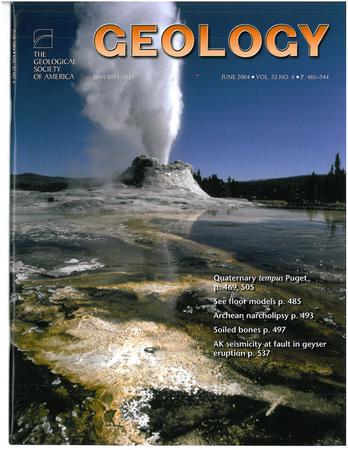New constraints on phosphate concentration and temperature in shallow late Tonian seawater
IF 4.6
1区 地球科学
Q1 GEOLOGY
引用次数: 0
Abstract
Although it is difficult to reconstruct Earth surface temperatures during Neoproterozoic time, sedimentological and paleomagnetic evidence demonstrate a dynamic climate, featuring two global “Snowball Earth” glaciations. The recent observation of petrographic fingerprints of ikaite, a mineral that typically forms in near-freezing sedimentary environments, in late Tonian strata was interpreted as evidence that low-latitude shallow marine environments were cold millions of years prior to the Cryogenian Period. Meanwhile, other recent work has demonstrated that elevated phosphate concentration ([DIP]) can inhibit calcite nucleation (perhaps enabling ikaite to form and persist at warmer temperatures) and that late Tonian carbonates formed in phosphate-rich seawater. So, was late Tonian seawater cold, or was it phosphate-rich? To address this question, we combined measurements of carbonate-associated phosphate and ooid-size-based pH constraints to reconstruct seawater [DIP] values for one snapshot of time in the late Tonian Period. Our seawater [DIP] estimates range from 3.8 µM to 7.8 µM, substantially elevated relative to modern shallow seawater and consistent with inferences from previous approaches. Our estimates are below values at which calcite nucleation inhibition has been observed, suggesting that elevated phosphate is an insufficient explanation for the ikaite forming in warm conditions and supporting the hypothesis that late Tonian climate was cool.晚托尼亚浅层海水中磷酸盐浓度和温度的新约束
虽然很难重建新元古代的地球表面温度,但沉积学和古地磁证据表明,新元古代的气候是动态的,具有两次全球性的“雪球地球”冰川作用。最近在晚第三纪地层中观察到的岩相指纹显示,一种通常形成于接近冰点的沉积环境的矿物,被解释为低纬度浅海环境在冰点纪之前数百万年是寒冷的证据。与此同时,最近的其他研究表明,磷酸盐浓度的升高([DIP])可以抑制方解石成核(可能使钙钛矿在较温暖的温度下形成并持续存在),并且在富磷酸盐的海水中形成晚托尼期碳酸盐。那么,托尼亚晚期的海水是冷的,还是富含磷酸盐的?为了解决这个问题,我们结合了碳酸盐相关磷酸盐和基于流体大小的pH约束的测量,重建了晚托尼期一个时间快照的海水[DIP]值。我们对海水[DIP]的估计范围为3.8µM至7.8µM,与现代浅海相比显著升高,与之前方法的推断一致。我们的估计值低于方解石成核抑制的观测值,这表明磷酸盐的升高不足以解释在温暖条件下形成的爱海岩,并支持了晚托尼气候是凉爽的假设。
本文章由计算机程序翻译,如有差异,请以英文原文为准。
求助全文
约1分钟内获得全文
求助全文
来源期刊

Geology
地学-地质学
CiteScore
10.00
自引率
3.40%
发文量
228
审稿时长
6.2 months
期刊介绍:
Published since 1973, Geology features rapid publication of about 23 refereed short (four-page) papers each month. Articles cover all earth-science disciplines and include new investigations and provocative topics. Professional geologists and university-level students in the earth sciences use this widely read journal to keep up with scientific research trends. The online forum section facilitates author-reader dialog. Includes color and occasional large-format illustrations on oversized loose inserts.
 求助内容:
求助内容: 应助结果提醒方式:
应助结果提醒方式:


